Cultural Anthropology Assignment: Analysis of Research Articles
VerifiedAdded on 2023/01/11
|10
|2601
|34
Report
AI Summary
This cultural anthropology assignment presents a comprehensive analysis of four key articles. The first article, by LiPuma and Koelble, examines the rituals of solidarity in post-apartheid South Africa, focusing on how Nelson Mandela fostered national unity across racial and cultural divides. The second article, by Vlad, delves into religious training in Eastern Christian monasticism, exploring the cognitive and sensory processes involved in acquiring religious knowledge and experiencing the presence of God. The third article, by Glazier, discusses the Trinidadian Orisa Movement, analyzing the complexities of belief and unbelief in the context of integrating West-African religious practices with other religions. Finally, the assignment reviews Coleman's article on pilgrimage, exploring the anthropological perspectives on pilgrimage as a journey of self-discovery and its distinction from rituals and tourism. The assignment provides insightful summaries and critical analyses of each article, highlighting key arguments, theoretical frameworks, and cultural implications.
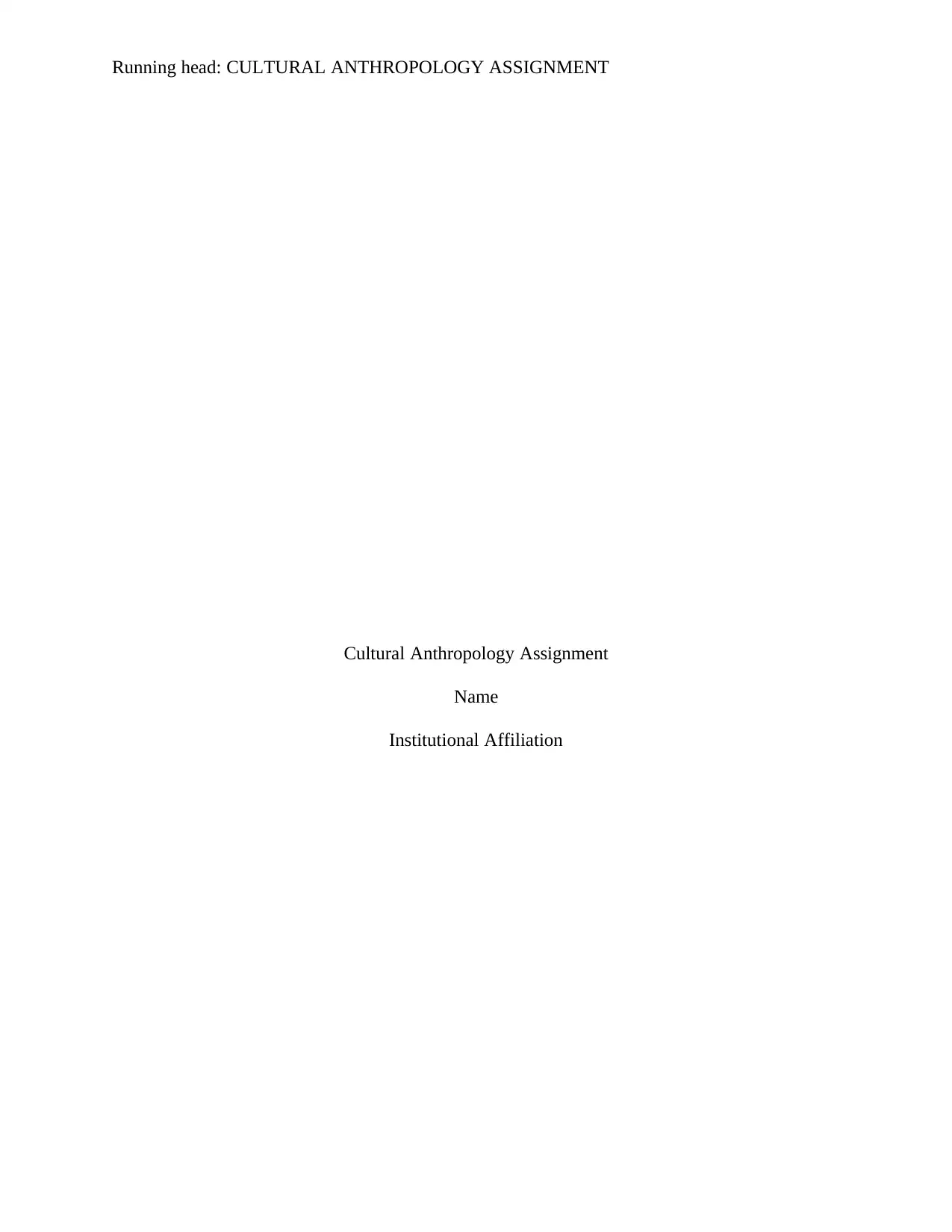
Running head: CULTURAL ANTHROPOLOGY ASSIGNMENT
Cultural Anthropology Assignment
Name
Institutional Affiliation
Cultural Anthropology Assignment
Name
Institutional Affiliation
Paraphrase This Document
Need a fresh take? Get an instant paraphrase of this document with our AI Paraphraser
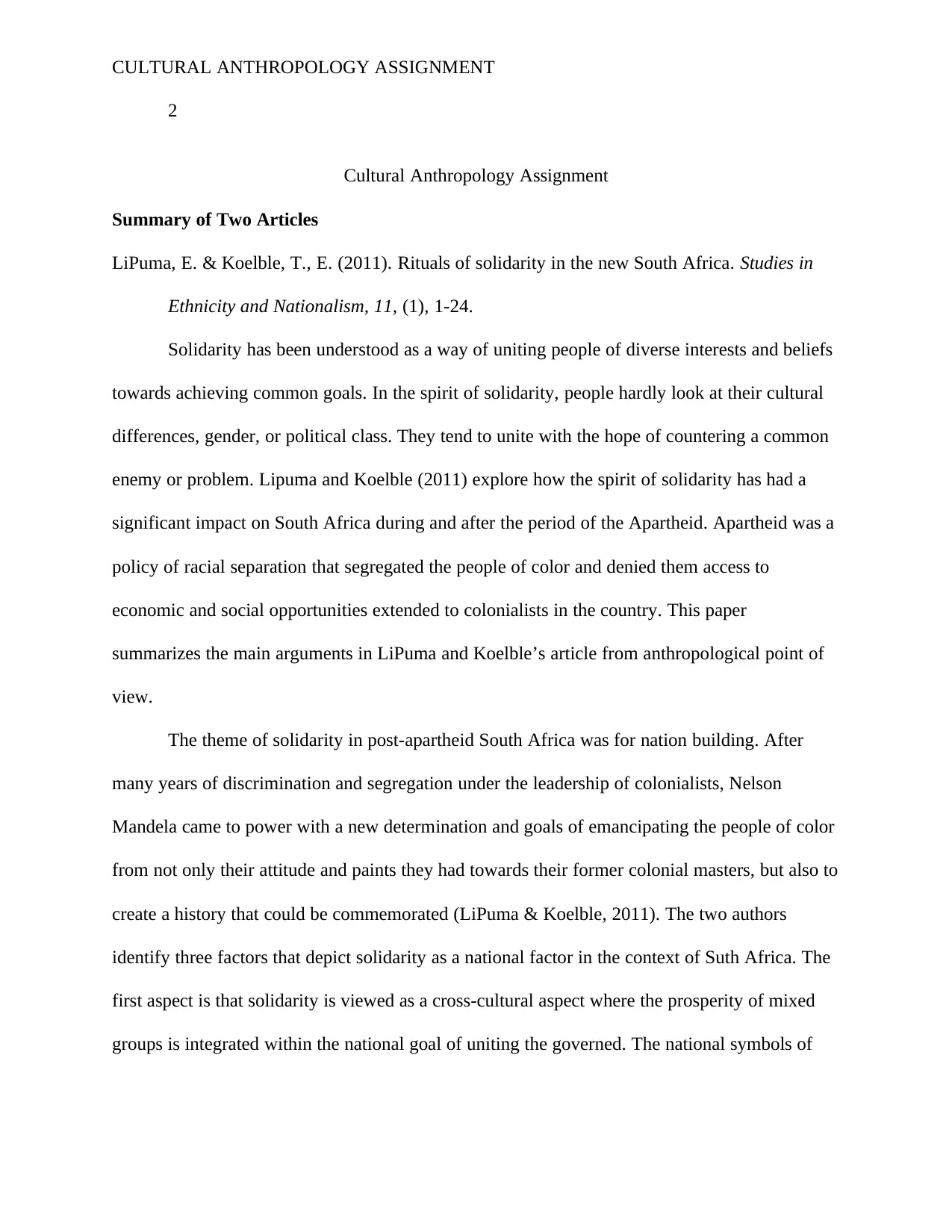
CULTURAL ANTHROPOLOGY ASSIGNMENT
2
Cultural Anthropology Assignment
Summary of Two Articles
LiPuma, E. & Koelble, T., E. (2011). Rituals of solidarity in the new South Africa. Studies in
Ethnicity and Nationalism, 11, (1), 1-24.
Solidarity has been understood as a way of uniting people of diverse interests and beliefs
towards achieving common goals. In the spirit of solidarity, people hardly look at their cultural
differences, gender, or political class. They tend to unite with the hope of countering a common
enemy or problem. Lipuma and Koelble (2011) explore how the spirit of solidarity has had a
significant impact on South Africa during and after the period of the Apartheid. Apartheid was a
policy of racial separation that segregated the people of color and denied them access to
economic and social opportunities extended to colonialists in the country. This paper
summarizes the main arguments in LiPuma and Koelble’s article from anthropological point of
view.
The theme of solidarity in post-apartheid South Africa was for nation building. After
many years of discrimination and segregation under the leadership of colonialists, Nelson
Mandela came to power with a new determination and goals of emancipating the people of color
from not only their attitude and paints they had towards their former colonial masters, but also to
create a history that could be commemorated (LiPuma & Koelble, 2011). The two authors
identify three factors that depict solidarity as a national factor in the context of Suth Africa. The
first aspect is that solidarity is viewed as a cross-cultural aspect where the prosperity of mixed
groups is integrated within the national goal of uniting the governed. The national symbols of
2
Cultural Anthropology Assignment
Summary of Two Articles
LiPuma, E. & Koelble, T., E. (2011). Rituals of solidarity in the new South Africa. Studies in
Ethnicity and Nationalism, 11, (1), 1-24.
Solidarity has been understood as a way of uniting people of diverse interests and beliefs
towards achieving common goals. In the spirit of solidarity, people hardly look at their cultural
differences, gender, or political class. They tend to unite with the hope of countering a common
enemy or problem. Lipuma and Koelble (2011) explore how the spirit of solidarity has had a
significant impact on South Africa during and after the period of the Apartheid. Apartheid was a
policy of racial separation that segregated the people of color and denied them access to
economic and social opportunities extended to colonialists in the country. This paper
summarizes the main arguments in LiPuma and Koelble’s article from anthropological point of
view.
The theme of solidarity in post-apartheid South Africa was for nation building. After
many years of discrimination and segregation under the leadership of colonialists, Nelson
Mandela came to power with a new determination and goals of emancipating the people of color
from not only their attitude and paints they had towards their former colonial masters, but also to
create a history that could be commemorated (LiPuma & Koelble, 2011). The two authors
identify three factors that depict solidarity as a national factor in the context of Suth Africa. The
first aspect is that solidarity is viewed as a cross-cultural aspect where the prosperity of mixed
groups is integrated within the national goal of uniting the governed. The national symbols of
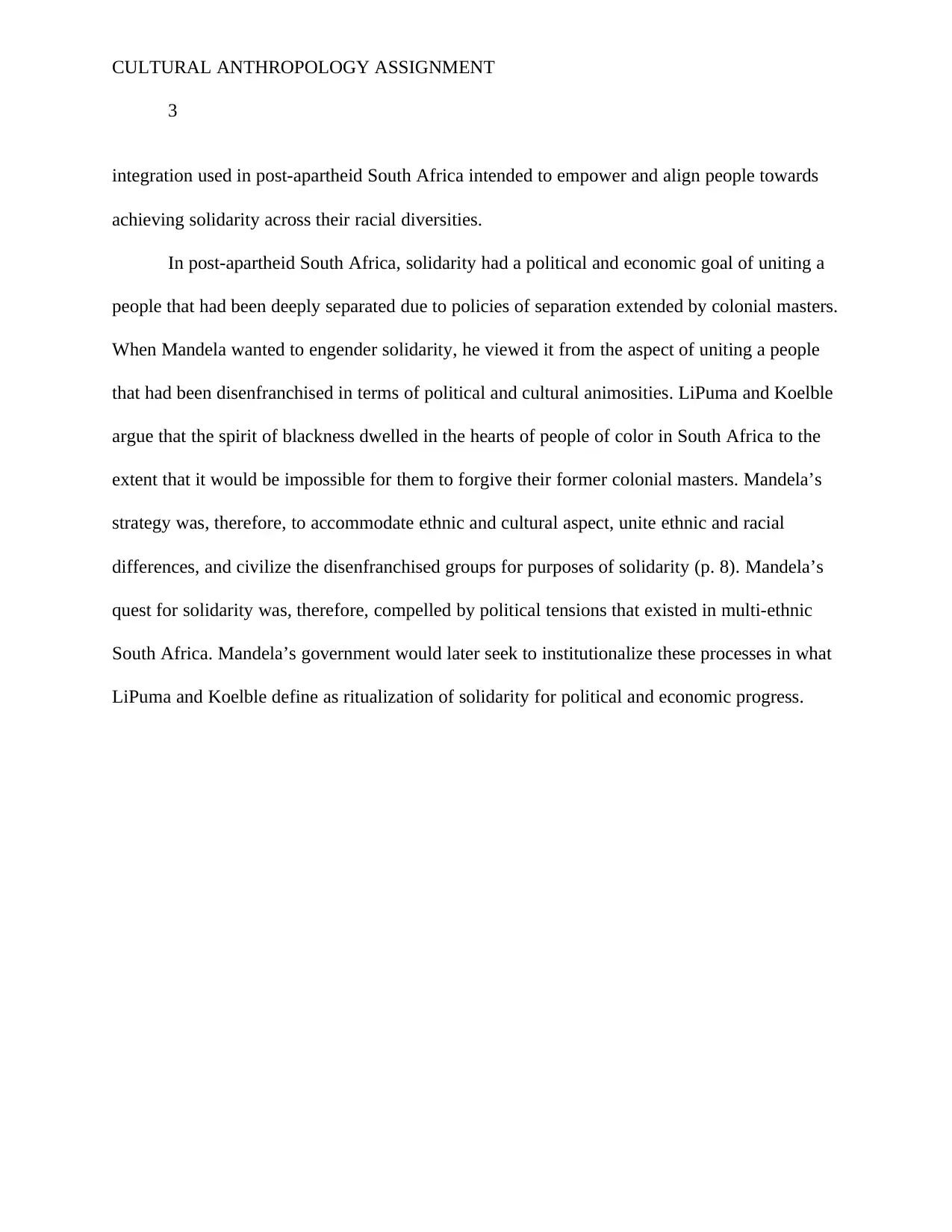
CULTURAL ANTHROPOLOGY ASSIGNMENT
3
integration used in post-apartheid South Africa intended to empower and align people towards
achieving solidarity across their racial diversities.
In post-apartheid South Africa, solidarity had a political and economic goal of uniting a
people that had been deeply separated due to policies of separation extended by colonial masters.
When Mandela wanted to engender solidarity, he viewed it from the aspect of uniting a people
that had been disenfranchised in terms of political and cultural animosities. LiPuma and Koelble
argue that the spirit of blackness dwelled in the hearts of people of color in South Africa to the
extent that it would be impossible for them to forgive their former colonial masters. Mandela’s
strategy was, therefore, to accommodate ethnic and cultural aspect, unite ethnic and racial
differences, and civilize the disenfranchised groups for purposes of solidarity (p. 8). Mandela’s
quest for solidarity was, therefore, compelled by political tensions that existed in multi-ethnic
South Africa. Mandela’s government would later seek to institutionalize these processes in what
LiPuma and Koelble define as ritualization of solidarity for political and economic progress.
3
integration used in post-apartheid South Africa intended to empower and align people towards
achieving solidarity across their racial diversities.
In post-apartheid South Africa, solidarity had a political and economic goal of uniting a
people that had been deeply separated due to policies of separation extended by colonial masters.
When Mandela wanted to engender solidarity, he viewed it from the aspect of uniting a people
that had been disenfranchised in terms of political and cultural animosities. LiPuma and Koelble
argue that the spirit of blackness dwelled in the hearts of people of color in South Africa to the
extent that it would be impossible for them to forgive their former colonial masters. Mandela’s
strategy was, therefore, to accommodate ethnic and cultural aspect, unite ethnic and racial
differences, and civilize the disenfranchised groups for purposes of solidarity (p. 8). Mandela’s
quest for solidarity was, therefore, compelled by political tensions that existed in multi-ethnic
South Africa. Mandela’s government would later seek to institutionalize these processes in what
LiPuma and Koelble define as ritualization of solidarity for political and economic progress.
⊘ This is a preview!⊘
Do you want full access?
Subscribe today to unlock all pages.

Trusted by 1+ million students worldwide
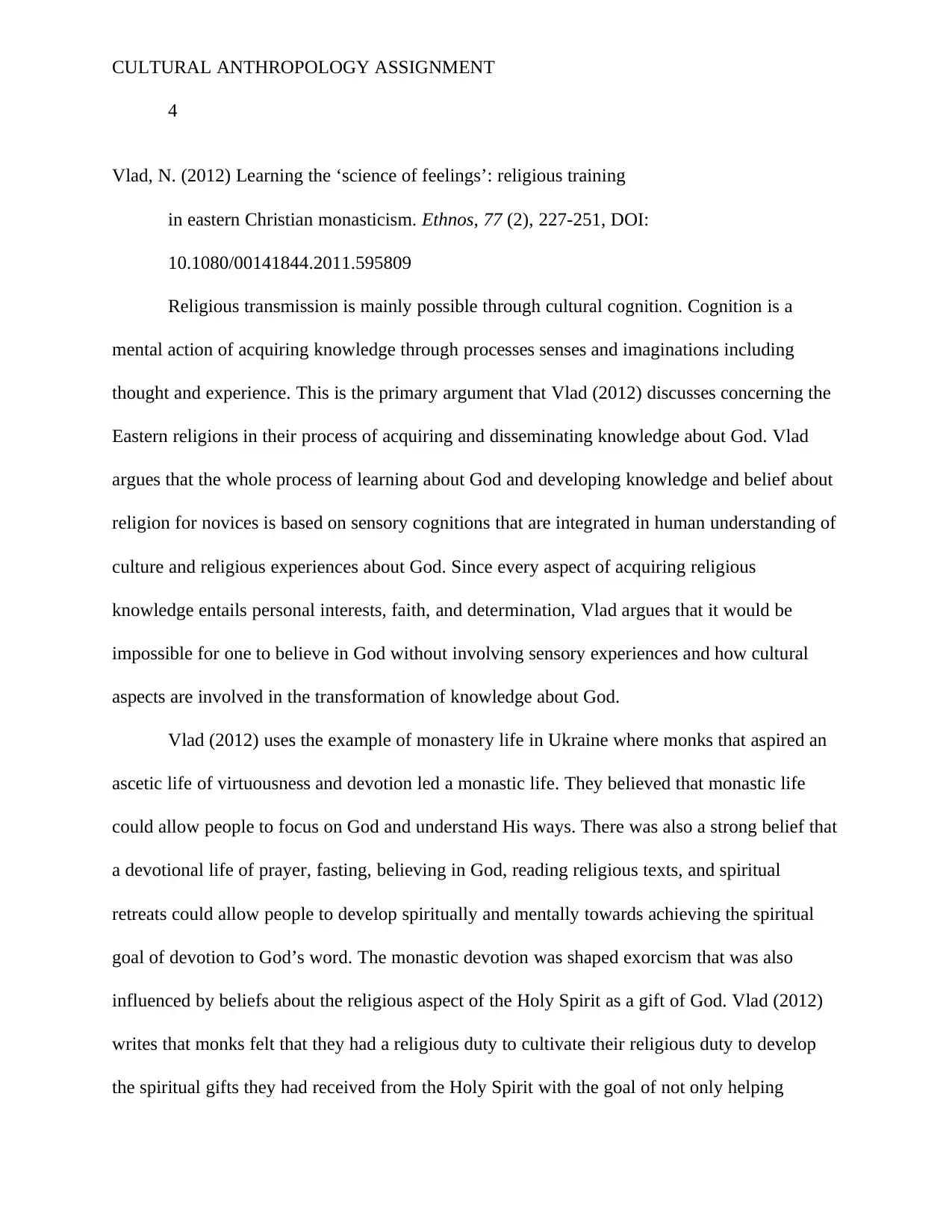
CULTURAL ANTHROPOLOGY ASSIGNMENT
4
Vlad, N. (2012) Learning the ‘science of feelings’: religious training
in eastern Christian monasticism. Ethnos, 77 (2), 227-251, DOI:
10.1080/00141844.2011.595809
Religious transmission is mainly possible through cultural cognition. Cognition is a
mental action of acquiring knowledge through processes senses and imaginations including
thought and experience. This is the primary argument that Vlad (2012) discusses concerning the
Eastern religions in their process of acquiring and disseminating knowledge about God. Vlad
argues that the whole process of learning about God and developing knowledge and belief about
religion for novices is based on sensory cognitions that are integrated in human understanding of
culture and religious experiences about God. Since every aspect of acquiring religious
knowledge entails personal interests, faith, and determination, Vlad argues that it would be
impossible for one to believe in God without involving sensory experiences and how cultural
aspects are involved in the transformation of knowledge about God.
Vlad (2012) uses the example of monastery life in Ukraine where monks that aspired an
ascetic life of virtuousness and devotion led a monastic life. They believed that monastic life
could allow people to focus on God and understand His ways. There was also a strong belief that
a devotional life of prayer, fasting, believing in God, reading religious texts, and spiritual
retreats could allow people to develop spiritually and mentally towards achieving the spiritual
goal of devotion to God’s word. The monastic devotion was shaped exorcism that was also
influenced by beliefs about the religious aspect of the Holy Spirit as a gift of God. Vlad (2012)
writes that monks felt that they had a religious duty to cultivate their religious duty to develop
the spiritual gifts they had received from the Holy Spirit with the goal of not only helping
4
Vlad, N. (2012) Learning the ‘science of feelings’: religious training
in eastern Christian monasticism. Ethnos, 77 (2), 227-251, DOI:
10.1080/00141844.2011.595809
Religious transmission is mainly possible through cultural cognition. Cognition is a
mental action of acquiring knowledge through processes senses and imaginations including
thought and experience. This is the primary argument that Vlad (2012) discusses concerning the
Eastern religions in their process of acquiring and disseminating knowledge about God. Vlad
argues that the whole process of learning about God and developing knowledge and belief about
religion for novices is based on sensory cognitions that are integrated in human understanding of
culture and religious experiences about God. Since every aspect of acquiring religious
knowledge entails personal interests, faith, and determination, Vlad argues that it would be
impossible for one to believe in God without involving sensory experiences and how cultural
aspects are involved in the transformation of knowledge about God.
Vlad (2012) uses the example of monastery life in Ukraine where monks that aspired an
ascetic life of virtuousness and devotion led a monastic life. They believed that monastic life
could allow people to focus on God and understand His ways. There was also a strong belief that
a devotional life of prayer, fasting, believing in God, reading religious texts, and spiritual
retreats could allow people to develop spiritually and mentally towards achieving the spiritual
goal of devotion to God’s word. The monastic devotion was shaped exorcism that was also
influenced by beliefs about the religious aspect of the Holy Spirit as a gift of God. Vlad (2012)
writes that monks felt that they had a religious duty to cultivate their religious duty to develop
the spiritual gifts they had received from the Holy Spirit with the goal of not only helping
Paraphrase This Document
Need a fresh take? Get an instant paraphrase of this document with our AI Paraphraser
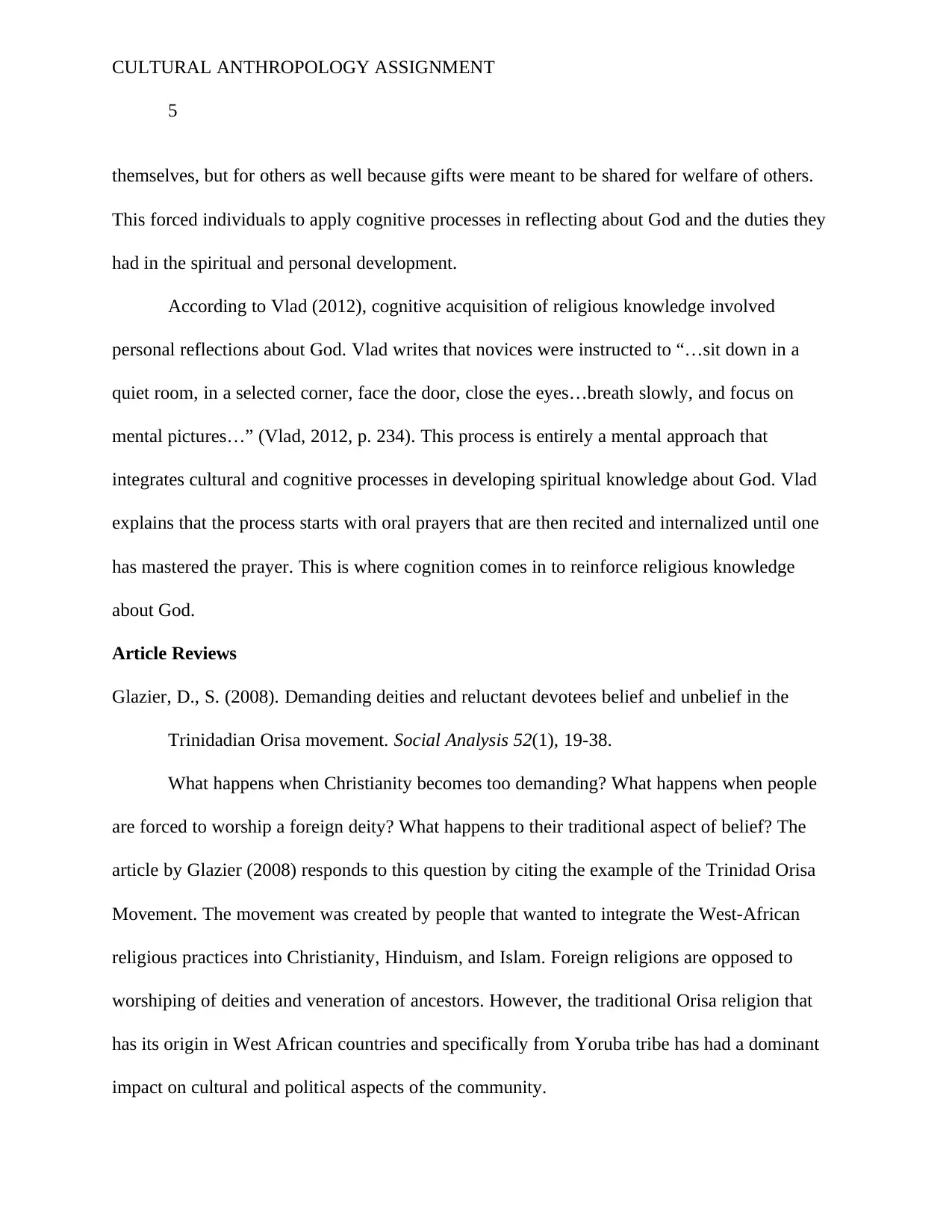
CULTURAL ANTHROPOLOGY ASSIGNMENT
5
themselves, but for others as well because gifts were meant to be shared for welfare of others.
This forced individuals to apply cognitive processes in reflecting about God and the duties they
had in the spiritual and personal development.
According to Vlad (2012), cognitive acquisition of religious knowledge involved
personal reflections about God. Vlad writes that novices were instructed to “…sit down in a
quiet room, in a selected corner, face the door, close the eyes…breath slowly, and focus on
mental pictures…” (Vlad, 2012, p. 234). This process is entirely a mental approach that
integrates cultural and cognitive processes in developing spiritual knowledge about God. Vlad
explains that the process starts with oral prayers that are then recited and internalized until one
has mastered the prayer. This is where cognition comes in to reinforce religious knowledge
about God.
Article Reviews
Glazier, D., S. (2008). Demanding deities and reluctant devotees belief and unbelief in the
Trinidadian Orisa movement. Social Analysis 52(1), 19-38.
What happens when Christianity becomes too demanding? What happens when people
are forced to worship a foreign deity? What happens to their traditional aspect of belief? The
article by Glazier (2008) responds to this question by citing the example of the Trinidad Orisa
Movement. The movement was created by people that wanted to integrate the West-African
religious practices into Christianity, Hinduism, and Islam. Foreign religions are opposed to
worshiping of deities and veneration of ancestors. However, the traditional Orisa religion that
has its origin in West African countries and specifically from Yoruba tribe has had a dominant
impact on cultural and political aspects of the community.
5
themselves, but for others as well because gifts were meant to be shared for welfare of others.
This forced individuals to apply cognitive processes in reflecting about God and the duties they
had in the spiritual and personal development.
According to Vlad (2012), cognitive acquisition of religious knowledge involved
personal reflections about God. Vlad writes that novices were instructed to “…sit down in a
quiet room, in a selected corner, face the door, close the eyes…breath slowly, and focus on
mental pictures…” (Vlad, 2012, p. 234). This process is entirely a mental approach that
integrates cultural and cognitive processes in developing spiritual knowledge about God. Vlad
explains that the process starts with oral prayers that are then recited and internalized until one
has mastered the prayer. This is where cognition comes in to reinforce religious knowledge
about God.
Article Reviews
Glazier, D., S. (2008). Demanding deities and reluctant devotees belief and unbelief in the
Trinidadian Orisa movement. Social Analysis 52(1), 19-38.
What happens when Christianity becomes too demanding? What happens when people
are forced to worship a foreign deity? What happens to their traditional aspect of belief? The
article by Glazier (2008) responds to this question by citing the example of the Trinidad Orisa
Movement. The movement was created by people that wanted to integrate the West-African
religious practices into Christianity, Hinduism, and Islam. Foreign religions are opposed to
worshiping of deities and veneration of ancestors. However, the traditional Orisa religion that
has its origin in West African countries and specifically from Yoruba tribe has had a dominant
impact on cultural and political aspects of the community.
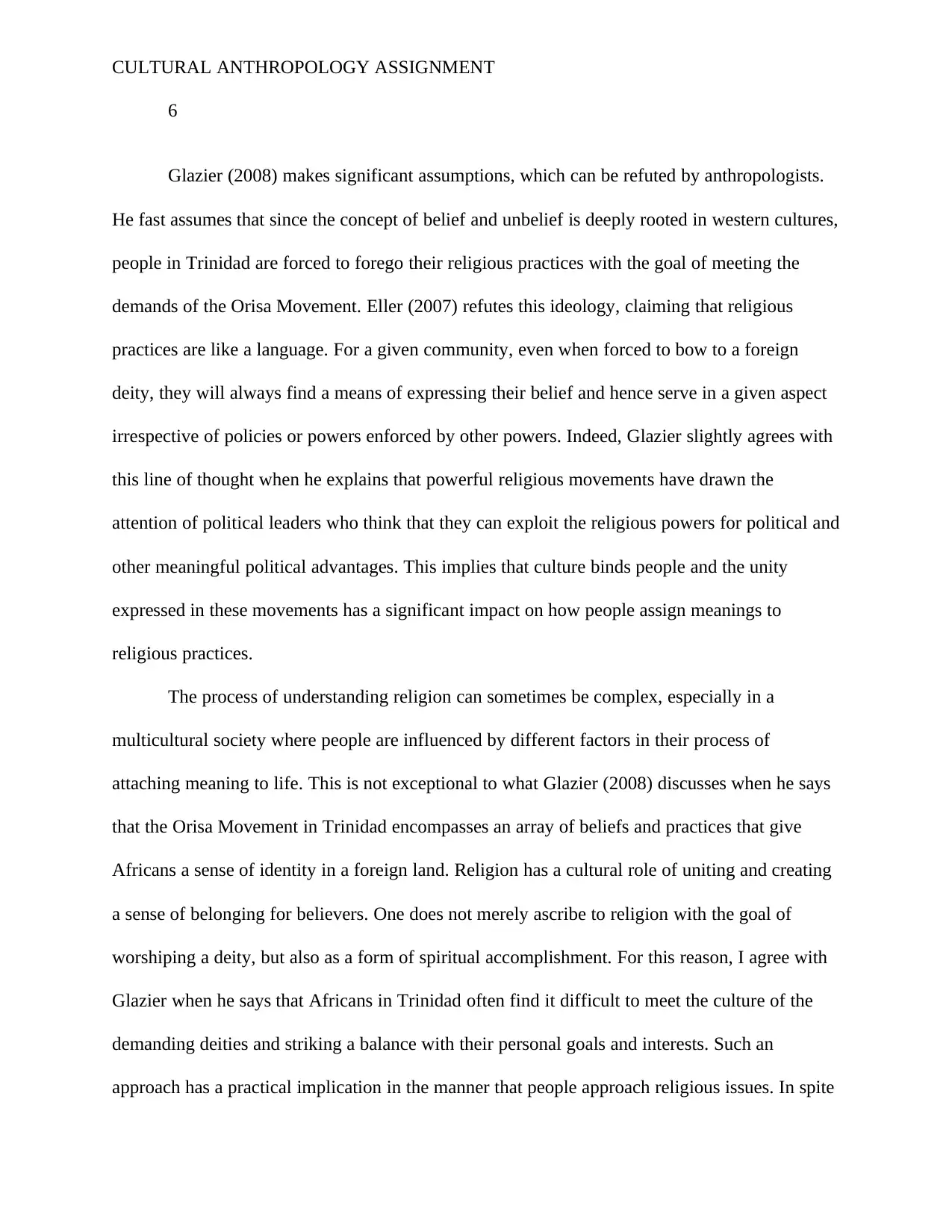
CULTURAL ANTHROPOLOGY ASSIGNMENT
6
Glazier (2008) makes significant assumptions, which can be refuted by anthropologists.
He fast assumes that since the concept of belief and unbelief is deeply rooted in western cultures,
people in Trinidad are forced to forego their religious practices with the goal of meeting the
demands of the Orisa Movement. Eller (2007) refutes this ideology, claiming that religious
practices are like a language. For a given community, even when forced to bow to a foreign
deity, they will always find a means of expressing their belief and hence serve in a given aspect
irrespective of policies or powers enforced by other powers. Indeed, Glazier slightly agrees with
this line of thought when he explains that powerful religious movements have drawn the
attention of political leaders who think that they can exploit the religious powers for political and
other meaningful political advantages. This implies that culture binds people and the unity
expressed in these movements has a significant impact on how people assign meanings to
religious practices.
The process of understanding religion can sometimes be complex, especially in a
multicultural society where people are influenced by different factors in their process of
attaching meaning to life. This is not exceptional to what Glazier (2008) discusses when he says
that the Orisa Movement in Trinidad encompasses an array of beliefs and practices that give
Africans a sense of identity in a foreign land. Religion has a cultural role of uniting and creating
a sense of belonging for believers. One does not merely ascribe to religion with the goal of
worshiping a deity, but also as a form of spiritual accomplishment. For this reason, I agree with
Glazier when he says that Africans in Trinidad often find it difficult to meet the culture of the
demanding deities and striking a balance with their personal goals and interests. Such an
approach has a practical implication in the manner that people approach religious issues. In spite
6
Glazier (2008) makes significant assumptions, which can be refuted by anthropologists.
He fast assumes that since the concept of belief and unbelief is deeply rooted in western cultures,
people in Trinidad are forced to forego their religious practices with the goal of meeting the
demands of the Orisa Movement. Eller (2007) refutes this ideology, claiming that religious
practices are like a language. For a given community, even when forced to bow to a foreign
deity, they will always find a means of expressing their belief and hence serve in a given aspect
irrespective of policies or powers enforced by other powers. Indeed, Glazier slightly agrees with
this line of thought when he explains that powerful religious movements have drawn the
attention of political leaders who think that they can exploit the religious powers for political and
other meaningful political advantages. This implies that culture binds people and the unity
expressed in these movements has a significant impact on how people assign meanings to
religious practices.
The process of understanding religion can sometimes be complex, especially in a
multicultural society where people are influenced by different factors in their process of
attaching meaning to life. This is not exceptional to what Glazier (2008) discusses when he says
that the Orisa Movement in Trinidad encompasses an array of beliefs and practices that give
Africans a sense of identity in a foreign land. Religion has a cultural role of uniting and creating
a sense of belonging for believers. One does not merely ascribe to religion with the goal of
worshiping a deity, but also as a form of spiritual accomplishment. For this reason, I agree with
Glazier when he says that Africans in Trinidad often find it difficult to meet the culture of the
demanding deities and striking a balance with their personal goals and interests. Such an
approach has a practical implication in the manner that people approach religious issues. In spite
⊘ This is a preview!⊘
Do you want full access?
Subscribe today to unlock all pages.

Trusted by 1+ million students worldwide
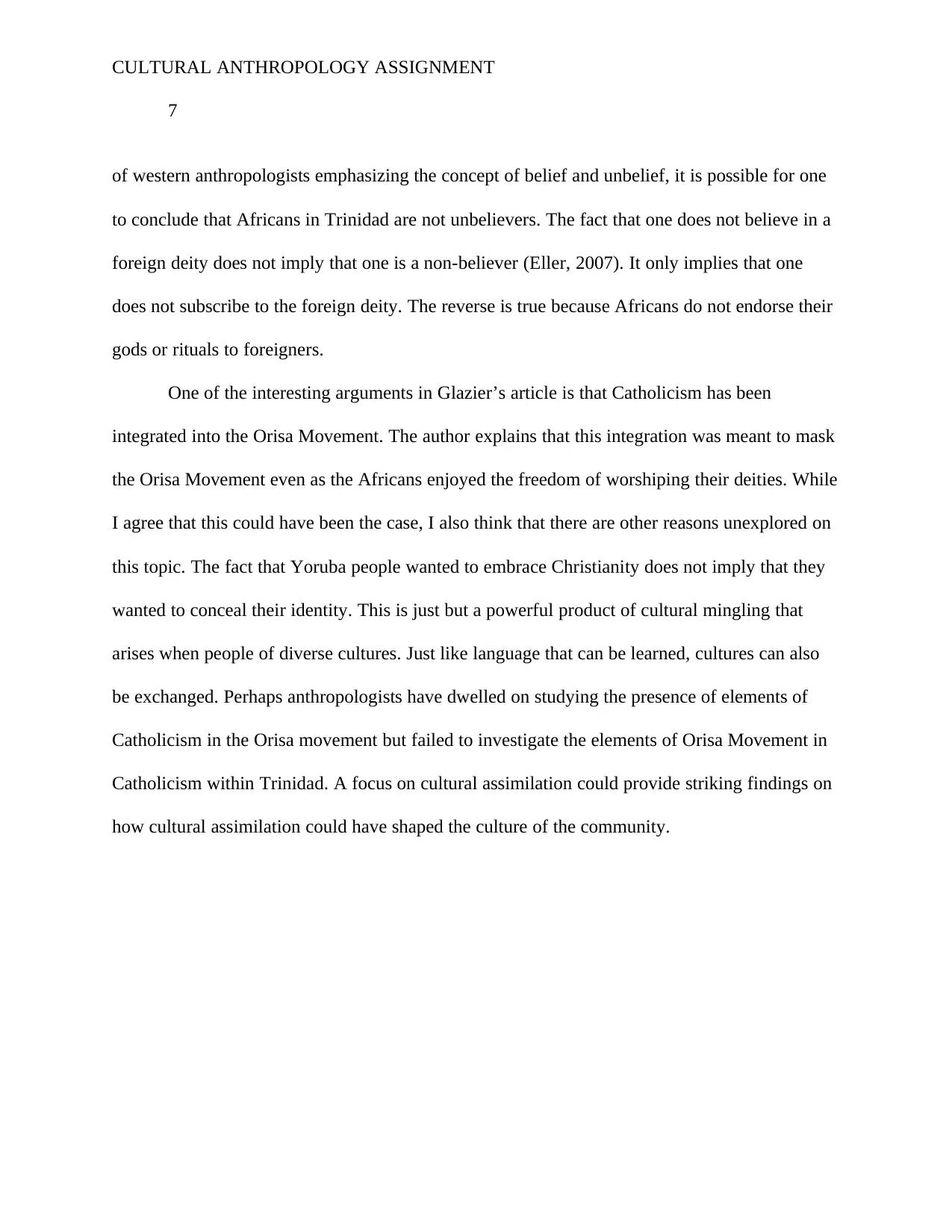
CULTURAL ANTHROPOLOGY ASSIGNMENT
7
of western anthropologists emphasizing the concept of belief and unbelief, it is possible for one
to conclude that Africans in Trinidad are not unbelievers. The fact that one does not believe in a
foreign deity does not imply that one is a non-believer (Eller, 2007). It only implies that one
does not subscribe to the foreign deity. The reverse is true because Africans do not endorse their
gods or rituals to foreigners.
One of the interesting arguments in Glazier’s article is that Catholicism has been
integrated into the Orisa Movement. The author explains that this integration was meant to mask
the Orisa Movement even as the Africans enjoyed the freedom of worshiping their deities. While
I agree that this could have been the case, I also think that there are other reasons unexplored on
this topic. The fact that Yoruba people wanted to embrace Christianity does not imply that they
wanted to conceal their identity. This is just but a powerful product of cultural mingling that
arises when people of diverse cultures. Just like language that can be learned, cultures can also
be exchanged. Perhaps anthropologists have dwelled on studying the presence of elements of
Catholicism in the Orisa movement but failed to investigate the elements of Orisa Movement in
Catholicism within Trinidad. A focus on cultural assimilation could provide striking findings on
how cultural assimilation could have shaped the culture of the community.
7
of western anthropologists emphasizing the concept of belief and unbelief, it is possible for one
to conclude that Africans in Trinidad are not unbelievers. The fact that one does not believe in a
foreign deity does not imply that one is a non-believer (Eller, 2007). It only implies that one
does not subscribe to the foreign deity. The reverse is true because Africans do not endorse their
gods or rituals to foreigners.
One of the interesting arguments in Glazier’s article is that Catholicism has been
integrated into the Orisa Movement. The author explains that this integration was meant to mask
the Orisa Movement even as the Africans enjoyed the freedom of worshiping their deities. While
I agree that this could have been the case, I also think that there are other reasons unexplored on
this topic. The fact that Yoruba people wanted to embrace Christianity does not imply that they
wanted to conceal their identity. This is just but a powerful product of cultural mingling that
arises when people of diverse cultures. Just like language that can be learned, cultures can also
be exchanged. Perhaps anthropologists have dwelled on studying the presence of elements of
Catholicism in the Orisa movement but failed to investigate the elements of Orisa Movement in
Catholicism within Trinidad. A focus on cultural assimilation could provide striking findings on
how cultural assimilation could have shaped the culture of the community.
Paraphrase This Document
Need a fresh take? Get an instant paraphrase of this document with our AI Paraphraser
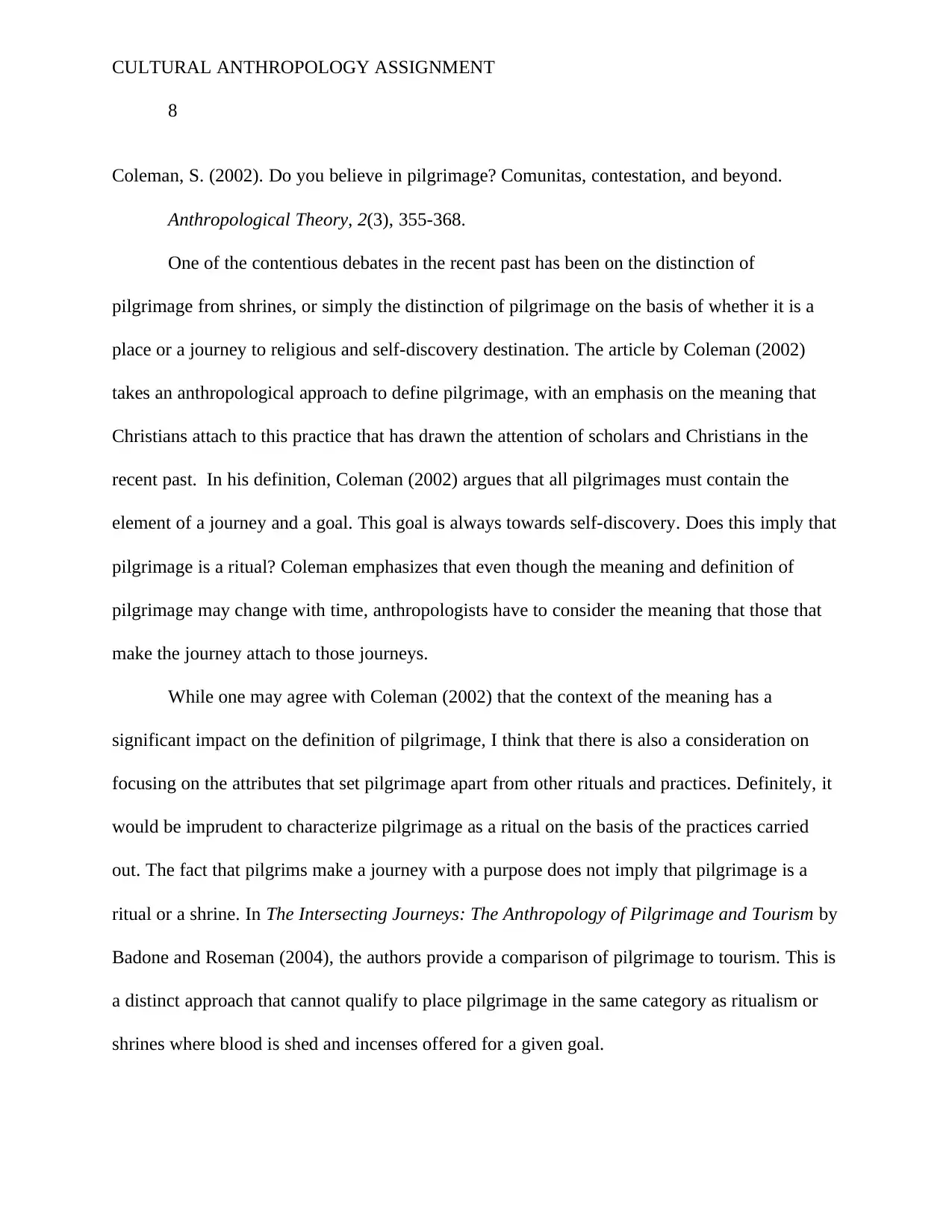
CULTURAL ANTHROPOLOGY ASSIGNMENT
8
Coleman, S. (2002). Do you believe in pilgrimage? Comunitas, contestation, and beyond.
Anthropological Theory, 2(3), 355-368.
One of the contentious debates in the recent past has been on the distinction of
pilgrimage from shrines, or simply the distinction of pilgrimage on the basis of whether it is a
place or a journey to religious and self-discovery destination. The article by Coleman (2002)
takes an anthropological approach to define pilgrimage, with an emphasis on the meaning that
Christians attach to this practice that has drawn the attention of scholars and Christians in the
recent past. In his definition, Coleman (2002) argues that all pilgrimages must contain the
element of a journey and a goal. This goal is always towards self-discovery. Does this imply that
pilgrimage is a ritual? Coleman emphasizes that even though the meaning and definition of
pilgrimage may change with time, anthropologists have to consider the meaning that those that
make the journey attach to those journeys.
While one may agree with Coleman (2002) that the context of the meaning has a
significant impact on the definition of pilgrimage, I think that there is also a consideration on
focusing on the attributes that set pilgrimage apart from other rituals and practices. Definitely, it
would be imprudent to characterize pilgrimage as a ritual on the basis of the practices carried
out. The fact that pilgrims make a journey with a purpose does not imply that pilgrimage is a
ritual or a shrine. In The Intersecting Journeys: The Anthropology of Pilgrimage and Tourism by
Badone and Roseman (2004), the authors provide a comparison of pilgrimage to tourism. This is
a distinct approach that cannot qualify to place pilgrimage in the same category as ritualism or
shrines where blood is shed and incenses offered for a given goal.
8
Coleman, S. (2002). Do you believe in pilgrimage? Comunitas, contestation, and beyond.
Anthropological Theory, 2(3), 355-368.
One of the contentious debates in the recent past has been on the distinction of
pilgrimage from shrines, or simply the distinction of pilgrimage on the basis of whether it is a
place or a journey to religious and self-discovery destination. The article by Coleman (2002)
takes an anthropological approach to define pilgrimage, with an emphasis on the meaning that
Christians attach to this practice that has drawn the attention of scholars and Christians in the
recent past. In his definition, Coleman (2002) argues that all pilgrimages must contain the
element of a journey and a goal. This goal is always towards self-discovery. Does this imply that
pilgrimage is a ritual? Coleman emphasizes that even though the meaning and definition of
pilgrimage may change with time, anthropologists have to consider the meaning that those that
make the journey attach to those journeys.
While one may agree with Coleman (2002) that the context of the meaning has a
significant impact on the definition of pilgrimage, I think that there is also a consideration on
focusing on the attributes that set pilgrimage apart from other rituals and practices. Definitely, it
would be imprudent to characterize pilgrimage as a ritual on the basis of the practices carried
out. The fact that pilgrims make a journey with a purpose does not imply that pilgrimage is a
ritual or a shrine. In The Intersecting Journeys: The Anthropology of Pilgrimage and Tourism by
Badone and Roseman (2004), the authors provide a comparison of pilgrimage to tourism. This is
a distinct approach that cannot qualify to place pilgrimage in the same category as ritualism or
shrines where blood is shed and incenses offered for a given goal.
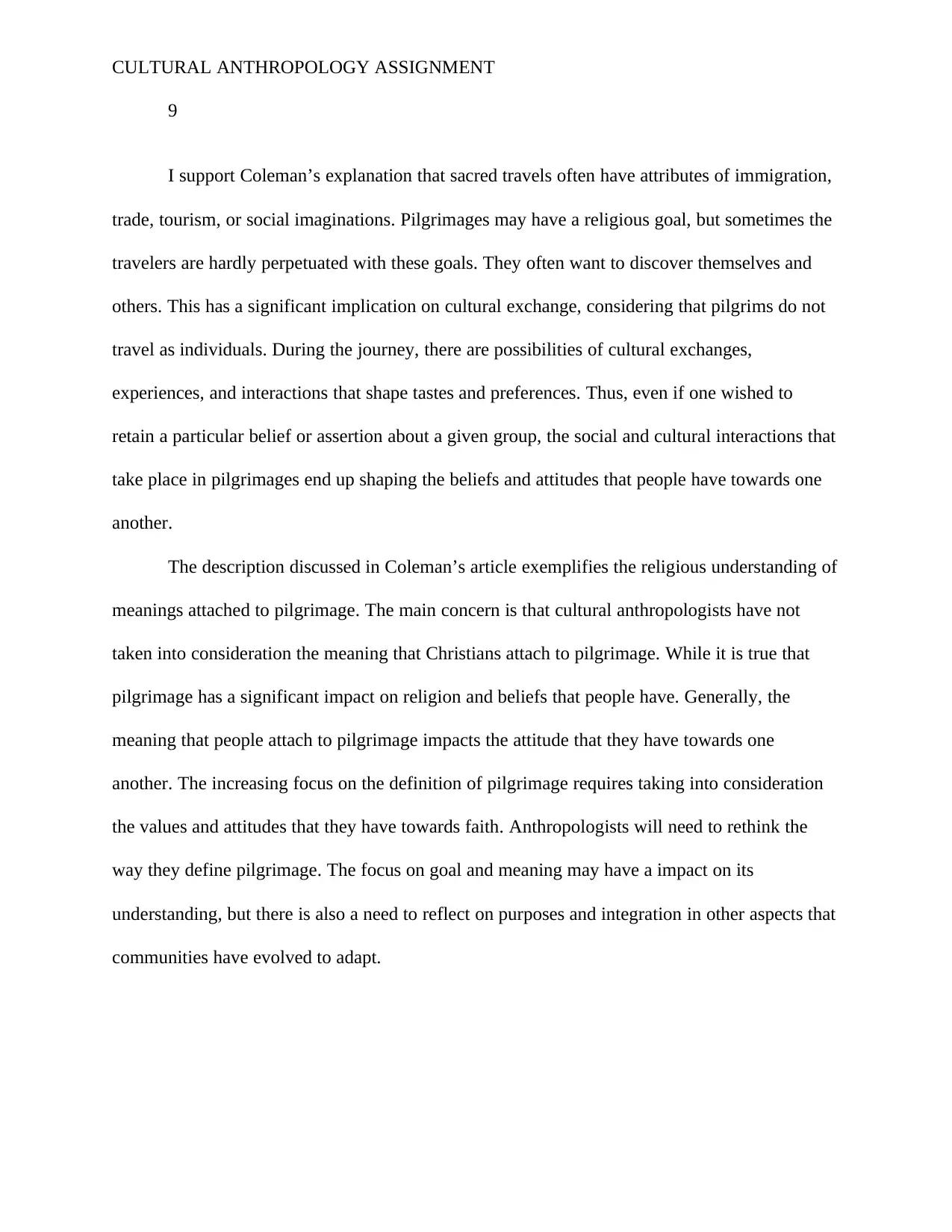
CULTURAL ANTHROPOLOGY ASSIGNMENT
9
I support Coleman’s explanation that sacred travels often have attributes of immigration,
trade, tourism, or social imaginations. Pilgrimages may have a religious goal, but sometimes the
travelers are hardly perpetuated with these goals. They often want to discover themselves and
others. This has a significant implication on cultural exchange, considering that pilgrims do not
travel as individuals. During the journey, there are possibilities of cultural exchanges,
experiences, and interactions that shape tastes and preferences. Thus, even if one wished to
retain a particular belief or assertion about a given group, the social and cultural interactions that
take place in pilgrimages end up shaping the beliefs and attitudes that people have towards one
another.
The description discussed in Coleman’s article exemplifies the religious understanding of
meanings attached to pilgrimage. The main concern is that cultural anthropologists have not
taken into consideration the meaning that Christians attach to pilgrimage. While it is true that
pilgrimage has a significant impact on religion and beliefs that people have. Generally, the
meaning that people attach to pilgrimage impacts the attitude that they have towards one
another. The increasing focus on the definition of pilgrimage requires taking into consideration
the values and attitudes that they have towards faith. Anthropologists will need to rethink the
way they define pilgrimage. The focus on goal and meaning may have a impact on its
understanding, but there is also a need to reflect on purposes and integration in other aspects that
communities have evolved to adapt.
9
I support Coleman’s explanation that sacred travels often have attributes of immigration,
trade, tourism, or social imaginations. Pilgrimages may have a religious goal, but sometimes the
travelers are hardly perpetuated with these goals. They often want to discover themselves and
others. This has a significant implication on cultural exchange, considering that pilgrims do not
travel as individuals. During the journey, there are possibilities of cultural exchanges,
experiences, and interactions that shape tastes and preferences. Thus, even if one wished to
retain a particular belief or assertion about a given group, the social and cultural interactions that
take place in pilgrimages end up shaping the beliefs and attitudes that people have towards one
another.
The description discussed in Coleman’s article exemplifies the religious understanding of
meanings attached to pilgrimage. The main concern is that cultural anthropologists have not
taken into consideration the meaning that Christians attach to pilgrimage. While it is true that
pilgrimage has a significant impact on religion and beliefs that people have. Generally, the
meaning that people attach to pilgrimage impacts the attitude that they have towards one
another. The increasing focus on the definition of pilgrimage requires taking into consideration
the values and attitudes that they have towards faith. Anthropologists will need to rethink the
way they define pilgrimage. The focus on goal and meaning may have a impact on its
understanding, but there is also a need to reflect on purposes and integration in other aspects that
communities have evolved to adapt.
⊘ This is a preview!⊘
Do you want full access?
Subscribe today to unlock all pages.

Trusted by 1+ million students worldwide
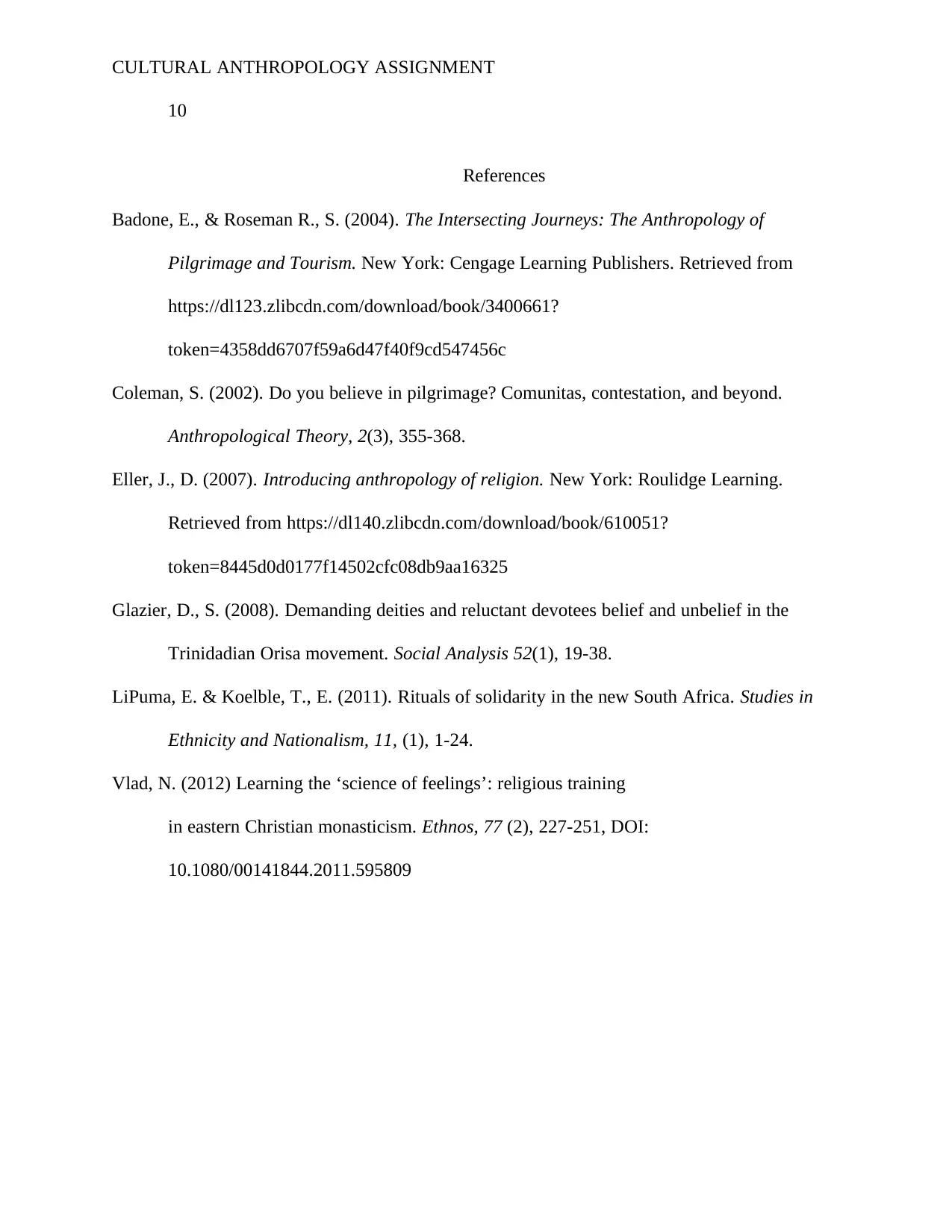
CULTURAL ANTHROPOLOGY ASSIGNMENT
10
References
Badone, E., & Roseman R., S. (2004). The Intersecting Journeys: The Anthropology of
Pilgrimage and Tourism. New York: Cengage Learning Publishers. Retrieved from
https://dl123.zlibcdn.com/download/book/3400661?
token=4358dd6707f59a6d47f40f9cd547456c
Coleman, S. (2002). Do you believe in pilgrimage? Comunitas, contestation, and beyond.
Anthropological Theory, 2(3), 355-368.
Eller, J., D. (2007). Introducing anthropology of religion. New York: Roulidge Learning.
Retrieved from https://dl140.zlibcdn.com/download/book/610051?
token=8445d0d0177f14502cfc08db9aa16325
Glazier, D., S. (2008). Demanding deities and reluctant devotees belief and unbelief in the
Trinidadian Orisa movement. Social Analysis 52(1), 19-38.
LiPuma, E. & Koelble, T., E. (2011). Rituals of solidarity in the new South Africa. Studies in
Ethnicity and Nationalism, 11, (1), 1-24.
Vlad, N. (2012) Learning the ‘science of feelings’: religious training
in eastern Christian monasticism. Ethnos, 77 (2), 227-251, DOI:
10.1080/00141844.2011.595809
10
References
Badone, E., & Roseman R., S. (2004). The Intersecting Journeys: The Anthropology of
Pilgrimage and Tourism. New York: Cengage Learning Publishers. Retrieved from
https://dl123.zlibcdn.com/download/book/3400661?
token=4358dd6707f59a6d47f40f9cd547456c
Coleman, S. (2002). Do you believe in pilgrimage? Comunitas, contestation, and beyond.
Anthropological Theory, 2(3), 355-368.
Eller, J., D. (2007). Introducing anthropology of religion. New York: Roulidge Learning.
Retrieved from https://dl140.zlibcdn.com/download/book/610051?
token=8445d0d0177f14502cfc08db9aa16325
Glazier, D., S. (2008). Demanding deities and reluctant devotees belief and unbelief in the
Trinidadian Orisa movement. Social Analysis 52(1), 19-38.
LiPuma, E. & Koelble, T., E. (2011). Rituals of solidarity in the new South Africa. Studies in
Ethnicity and Nationalism, 11, (1), 1-24.
Vlad, N. (2012) Learning the ‘science of feelings’: religious training
in eastern Christian monasticism. Ethnos, 77 (2), 227-251, DOI:
10.1080/00141844.2011.595809
1 out of 10
Your All-in-One AI-Powered Toolkit for Academic Success.
+13062052269
info@desklib.com
Available 24*7 on WhatsApp / Email
![[object Object]](/_next/static/media/star-bottom.7253800d.svg)
Unlock your academic potential
Copyright © 2020–2025 A2Z Services. All Rights Reserved. Developed and managed by ZUCOL.